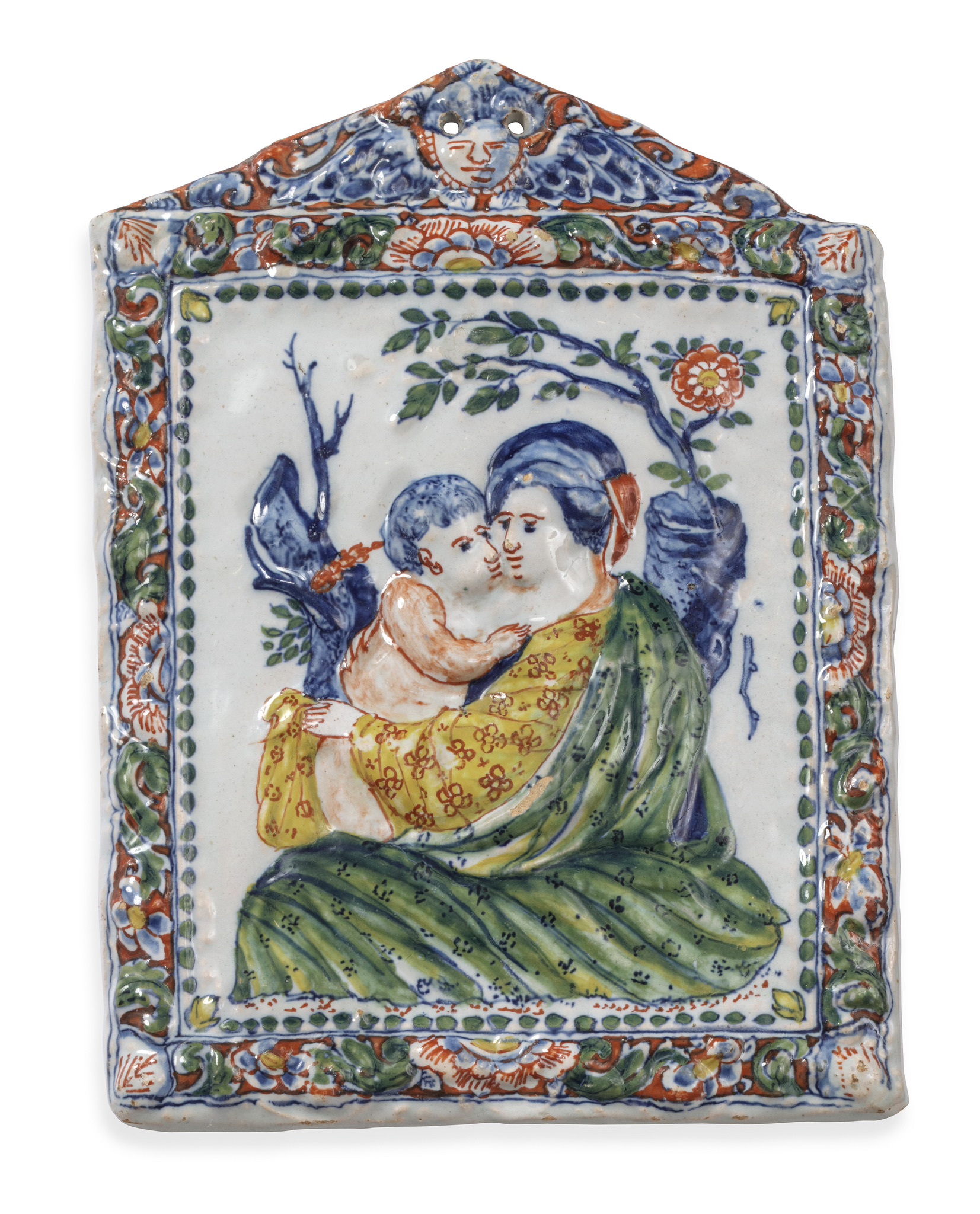![]()
Images on this website are licensed under a
Creative Commons Attribution-NoDerivs 3.0 Unported License.
A locked NFC tag has been applied to this object [more information]
OBJECT
•D2328. Polychrome Biblical Plaque
Delft, circa 1735
Painted in blue, green, yellow and iron-red, the center of the plaque is molded in relief with the Madonna and Child in an exterior setting with a tree trunk and a peach blossom branch beyond, the self-frame molded with foliate scrolls and blossoms, and a triangular crest with a cupid head and wings with two holes for suspension.
DIMENSIONS
Height 20.8 cm (8.2 in.)
PROVENANCE
A. Vromen Jr., Doetinchem, according to the original collector’s label;
Christie’s Laren, October 24, 1979, lot 2825 (according to family archive);
Dutch Private Collection, Amsterdam and hence by family descent
PROVENANCE+
The complete provenance of this entry has been registered by notarial deed with independent and secure registration agency Provenance+ Amsterdam.
LITERATURE
Described and illustrated in Vrienden van de Nederlandse ceramiek, vol. 48, 1967, p. 34, ill. 31.
NOTE
The Eighty Years’ War (1568-1648), or the Dutch War of Independence, transformed the Netherlands and gave birth to the Dutch Republic. The war grappled with freedom of religion and conscience, the right to self-determination and the right to participation. The leitmotif of the war was the emerging reformation and the fact that the Spanish king, who ruled in the Netherlands, continued to cling to the exclusive right of the Roman Catholic Church. The Dutch Revolt largely determined the conventions; where the Netherlands used to be Roman Catholic, the Republic became largely Protestant.
Although the seventeenth-century was considered a tolerant time, religious freedom was mostly reserved for the Calvinist Reformed Church. There was little tolerance shown towards other denominations. The Dutch were expected to convert to the Dutch Reformed Church. However, people and groups considered as foreigners, such as the Jews, were able to practice their religion freely. Dutch Catholics were the greatest minority and were forced to live on the margins, but they were “tolerated” and not expelled
or killed as happened in England and Scotland. All churches were confiscated, so Catholics and followers of other forbidden religions practiced their faith in hidden and illegal churches in existing buildings.
The public worship of images was prohibited under the Dutch Reformed Church. Therefore, Catholics practiced their faith at home and decorated their houses with Biblical objects. Delft factories produced a range of Biblical objects, from entire domestic altars for wealthy Catholics, to smaller statues and plaques like the present representing the Madonna and Child.
Although it was not the image, but the word that was central to the interest of the Dutch Reformed people of the seventeenth and eighteenth centuries, some nuancesshouldbeadded.Manypublicationsofthe Bible were illustrated with prints, and even separate picture Bibles were produced, which brought the scenes to a wide audience. Painters, engravers and etchers created Biblical illustrations, which were included or bound in the text in the new Bible editions. The Delftware factories also took an interest in Biblical subjects and applied them on Delftware. These objects were purchased not only by Catholics, but also by Protestants for visual support of the Bible.
This plaque is based on European Renaissance art in form and representation. Characteristic is the relief of the colorful flower frame, which must have been borrowed from a foreign example. The representation of the Madonna and Child is modeled entirely in the style of Italian Renaissance sculptor Andrea della Robbia (1435-1525).
SIMILAR EXAMPLES
A similar blue and white plaque is illustrated in Aronson 2003, p. 28, no. 25 and another is in the Victoria & Albert Museum, London (inv. no. 3075- 1853). A polychrome example was auctioned at Christie’s Amsterdam in 2003, and another is in the collection of the Kunstmuseum in The Hague, inv. no. 1059737.










